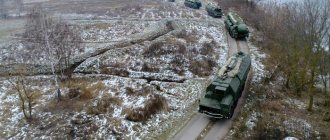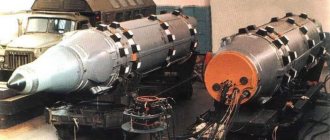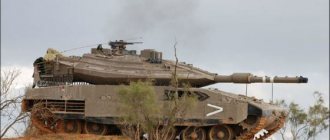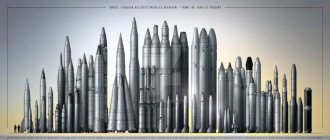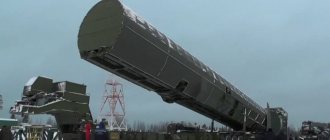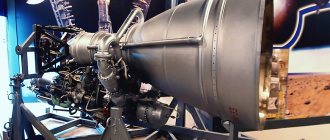Author: albin0s
20 October 2016 13:42
Tags: Russian Armed Forces missiles facts
7681
23
Ballistic missiles have been and remain a reliable shield of Russia's national security. A shield, ready, if necessary, to turn into a sword. Source: 7 Russian ballistic missiles that our adversaries fear
0
See all photos in the gallery
R-36M "Satan"
0
Developer: Yuzhnoye Design Bureau Length: 33, 65 m Diameter: 3 m Launch weight: 208,300 kg Flight range: 16,000 km Third generation Soviet strategic missile system, with a heavy two-stage liquid-propelled, ampulized intercontinental ballistic missile 15A14 for placement in a silo launcher 15P714 increased security OS type.
×
0
The Americans called the Soviet strategic missile system “Satan”. When first tested in 1973, the missile was the most powerful ballistic system ever developed.
0
Not a single missile defense system was capable of resisting the SS-18, whose destruction radius was as much as 16 thousand meters. After the creation of the R-36M, the Soviet Union did not have to worry about the “arms race.”
0
However, in the 1980s, the Satan was modified, and in 1988, a new version of the SS-18, the R-36M2 Voevoda, entered service with the Soviet Army, against which even modern American missile defense systems cannot do anything.
Impenetrable Russia. The most deadly missile systems of the Russian Federation
Assistant Chief of Staff of the Royal Air Force Julian Ball called the S-400, Bastion-P and Iskander-M missile systems the most lethal types of Russian-made weapons. It was thanks to these systems, in his opinion, that Moscow was able to implement the defense strategy of “access and maneuver restricted zones” - A2/AD in the NATO classification.
As part of this strategy, clusters of the above-mentioned anti-aircraft missile systems of the Russian Armed Forces create a multi-stage defense in depth of the country's land and water borders, both on the ground and in the sky. This protection is so well thought out and powerful that it is almost impossible for a potential enemy to open it. At the same time, Ball expressed hope that in the future, perhaps, NATO military experts will be able to develop a counter-strategy against the Russian A2/AD method using artificial intelligence and the latest types of weapons of future generations.
Coastal missile system "Bastion-P" to protect coastal waters and coastlines of the Russian Federation
"Bastion-P" is truly a killer of any surface craft, regardless of their class or displacement.
With the help of the Onyx unified homing missile, this DBK can sink any ship - be it the flagship of an aircraft carrier strike group or a single escort vessel. Moreover, radio-contrast vessels will not avoid being hit by Onyx, even under conditions of active radio suppression and multi-frequency electrical interference. One such complex is capable of effectively defending a coastline with a length of about six hundred kilometers. At this distance, not a single landing party of a potential enemy will be able to land unnoticed and unattacked. The deployment of the ballistic missile system takes only five minutes, after which it is completely ready for an aimed salvo at a visible and visually invisible target.
In addition to the Onyx missiles, the Bastion-P complex is reinforced with K-340P self-propelled launchers with a crew of three military personnel and a K-380R armored combat control vehicle with a crew of four. What makes the DBK unique is its autonomous robotic combat control system, as well as the information and technical interface system for the complex’s combat assets with the head command post. It is logical that such a multifunctional army complex is complemented by an automated maintenance system.
On the world arms market, Bastion-P is the best in its class. It is not surprising that many countries that have access to water are interested in it. Vietnam was one of the first to acquire this type of missile defense system from Russia.
Operational-tactical complex "Iskander-M" for the protection of Russian land territories
Iskander-M is a high-precision operational-tactical missile system of the ground forces of the Russian Federation. Its main task is to carry out targeted missile strikes on priority and key, often small-sized targets of a hypothetical enemy throughout the depth of deployment of its combat forces. This complex operates against a wide variety of purposes and targets: firing points, headquarters bunkers, anti-aircraft and anti-missile weapons and electronic warfare systems, even Air Force aircraft at approach or home airfields.
The echelon to which the Iskander sends the complex’s warhead is determined by a distance of 50-55 kilometers. At such altitudes, not a single air defense system that currently exists can reach and shoot it down. Moreover, the complex is mobile enough to remain invisible even when firing: in just one minute, the Iskander-M can fire two missiles and disappear from the launch site, turning off all the instruments by which enemy radar could detect it.
At the same time, the flight of a missile fired by the complex is unpredictable: both immediately after launch and on approach to the target, the projectile actively maneuvers, which makes its interception almost impossible. In addition, the interceptor missile must reach speeds and withstand overloads two to three times higher than the Iskander projectile, and this is technically infeasible today.
Strategically, Iskander-M complexes are scattered throughout Russia so that they cover the entire territory and coastal waters of the country with sufficient backup between neighboring batteries. One of these operational-tactical missile systems is deployed in the Kaliningrad region. Accordingly, almost the entire Baltic states and part of Eastern Europe fall under his sights.
Anti-aircraft missile system S-400 "Triumph" protecting the Russian sky
The legendary Russian-assembled S-400 Triumph air defense systems are considered the most advanced air defense/missile defense systems in the world. They are far superior to their American counterparts: the Patriot and THAAD systems. The US air defense system fires at a distance of no further than one hundred and twenty kilometers, while the S-400’s engagement range is about four hundred kilometers. In addition, the American system does not know how to shoot “beyond the horizon,” while the Russian system does this easily and accurately.
It is with the help of the S-400 that Russia is so reliably covered from the air. The Triumphs embody the latest advances in radio electronics and ballistic missile technology. These air defense systems are equipped with the latest generation radar stations. Thanks to them, the S-400 can spot and destroy almost any flying object, including reconnaissance aircraft with stealth technology.
The S-400 is also unique in that it has in its combat arsenal as many as four types of missiles with different weights, with a wide variety of combat capabilities and missions. And this allows one Triumph complex to perform the function of an almost complete multi-stage air defense system. The latest missiles for this anti-aircraft missile system can shoot down a target at a distance of up to two hundred and forty kilometers. Moreover, the S-400 can intercept ICBMs and interchangeable modular missiles.
It turns out that in strategic clusters, all of the above missile systems really become an almost impenetrable defensive shield of Russia: Bastions-P stand guard over the coastlines, the land territory of the Russian Federation is under the protection of Iskander-M, and the Russian sky is reliably covered by Triumphs S -400. All together they are practically insurmountable and invulnerable. The British military is absolutely right in this opinion.
RT-2PM2. "Topol M"
0
Developer: Central Design Bureau for Mechanical Engineering Length: 22.7 m Diameter: 1.86 m Launch weight: 47.1 t Flight range: 11000 km
0
The RT-2PM2 rocket is designed as a three-stage rocket with a powerful mixed solid fuel power plant and a fiberglass body. Testing of the rocket began in 1994. The first launch was carried out from a silo launcher at the Plesetsk cosmodrome on December 20, 1994. In 1997, after four successful launches, mass production of these missiles began.
0
The act on the adoption of the Topol-M intercontinental ballistic missile into service by the Strategic Missile Forces of the Russian Federation was approved by the State Commission on April 28, 2000. As of the end of 2012, there were 60 silo-based and 18 mobile-based Topol-M missiles on combat duty. All silo-based missiles are on combat duty in the Taman Missile Division (Svetly, Saratov Region).
Types of Russian missiles
Intercontinental ballistic missiles
Based on the type of deployment, intercontinental ballistic missiles (ICBMs) are divided into those launched:
- from silo launchers (silos) - RS-18, PC-20;
- from mobile launchers based on a wheeled chassis - “Topol”;
- from railway devices - RT-23UTTKh “Molodets”;
- from the sea/ocean bottom - “Skif”;
- from submarines - “Bulava”.
RS-20 intercontinental ballistic missile
The silos used today provide excellent protection from the damaging factors of a nuclear explosion and camouflage preparations for launch quite well. Other methods of deploying missiles guarantee high mobility and, accordingly, are more difficult to detect, but limit the army and navy in the size and weight of ICBMs.
High precision cruise missiles
Five of the most dangerous domestically produced cruise missiles:
- Family "Caliber". They primarily attack the personnel and infrastructure of “opposition” militants and outright terrorists in Syria. Development, which started in the 1980s on the basis of the strategic nuclear 3M10 and the anti-ship Alpha, was completed in 1993. In NATO they are codified as Sizzler. The strike range against offshore targets is up to 350 km, against coastal targets – up to 2600;
- Strategic air-to-ground missile X-101 (variation with a nuclear warhead - X-102). Designed by KB "Raduga" by 2013. It was also used in Syria for the above purposes. Mainly included in the armament kit of Tu-22 and Tu-160 bombers. The exact parameters of the X-101 are hidden from the public, but according to unofficial information, its maximum range is about 9 thousand km;
- Anti-ship P-270 “Mosquito” (NATO codified as SS-N-22 Sunburn). Created in the 1970s in the USSR. Can sink any ships with a displacement of up to 20 thousand tons. Range - up to 120 km along a low-altitude trajectory and 250 km along a high-altitude trajectory. To overcome the air defense (missile defense) system, it makes a “snake” maneuver;
- Strategic aviation X-55, air-to-ground class - for Tu-95 and Tu-160 bombers. It moves at subsonic speed, skirting the landscape below, making interception much more difficult. The power of the explosion is more than 20 times greater than that of the notorious Little Boy dropped by the Americans on Hiroshima in 1945;
- P-700 "Granit" is a long-range anti-ship missile designed to defeat large enemy ship and ship-aviation groups. Hit objects at a distance of up to 550 km. The heavy cruiser-aircraft carrier Admiral Kuznetsov, among others, is armed with P-700 devices.
Launch of the P-700 Granit anti-ship missile
Anti-ship missiles
In addition to the above-mentioned cruise anti-ship missiles, it is necessary to note the X-35 missile together with the Uran missile launcher, created in 1995 by the state.
The X-35 is capable of sinking ships with a displacement of up to 5 thousand tons. Thanks to its compact dimensions and low weight, it is used as weapons for ships of any class, including corvettes and boats, as well as weapons for various aircraft, including helicopters and light fighters. Coastal missile launchers "Bal" have been created for X-35 launches.
The X-35 has a two-stage structure, including a launch accelerator, a propulsion engine, and an active radar homing system. The range reaches 260 kilometers. The damaging part is high explosive, weighing 145 kg.
Russian aviation missiles
A particularly formidable asset of the Russian Air Force is the modernized variation of the R-37M Strela. This guided air-to-air missile is No. 1 in range in the world.
It is codified by NATO as the AA-13 "Arrow".
Used as a weapon:
- Su-27 heavy fighters;
- super-maneuverable Su-35 fighters;
- MiG-31BM fighter-interceptors.
The unique properties of the R-37M are dynamic instability and highest maneuverability. They allow it, bypassing all enemy anti-missile defenses, to hit a flying target that has approached the fighter at 300 kilometers or less.
According to a number of military experts, the R-37M and the similar Chinese PL-15 are capable of easily shooting down American aerial tankers that support non-stop flights of their strategic bombers, as well as reconnaissance, control and electronic warfare (EW) aircraft. Victories in today's wars are simply impossible without the listed auxiliary aircraft, while the effectiveness of the latest air-to-air missiles from Russia and China deprives the United States of an advantage in the air.
The supernova domestic air-to-surface weapon is the Kh-47M2 Kinzhal hypersonic missile, designed to destroy ground and surface targets. According to authoritative media reports, the Kinzhal RK is an aircraft modification of the Iskander family. The range of a device with a 500-kg warhead is determined by the properties of the bomber and ranges from 2 thousand to 3 thousand kilometers.
MiG-31 aircraft with Kh-47M2 "Dagger" missile
New Russian missile developments
Nowadays, the Russian army is being rearmed with new missiles:
- RS-24 "Yars", which are gradually replacing the RS-18 and RS-20 ICBMs (as their service life expires);
- RS-26 "Rubezh" - high-precision ICBM;
- RS-28 Sarmat is a heavy ICBM that effectively bypasses American missile defense systems, especially due to launches through the South Pole;
- X-50 - a new operational-tactical air-to-ground missile, virtually invisible to air defense systems;
- S-500 "Prometheus" is the latest air defense and missile defense missile system.
The newest Zircon-S missile launcher with a next-generation strategic hypersonic missile is also being developed.
In addition, in light of the emergence of hypersonic air-to-surface missiles Kh-47M2 (Kinzhalov), experts predict the successful completion of the development of hypersonic air-to-air weapons.
PC-24 "Yars"
0
Developer: MIT Length: 23 m Diameter: 2 m Flight range: 11000 km
0
The first rocket launch took place in 2007. Unlike Topol-M, it has multiple warheads. In addition to warheads, Yars also carries a set of missile defense penetration capabilities, which makes it difficult for the enemy to detect and intercept it.
0
This innovation makes the RS-24 the most successful combat missile in the context of the deployment of the global American missile defense system.
SRK UR-100N UTTH with 15A35 missile
0
Developer: Central Design Bureau for Mechanical Engineering Length: 24.3 m Diameter: 2.5 m Launch weight: 105.6 t Flight range: 10,000 km
0
The third generation intercontinental ballistic liquid missile 15A30 (UR-100N) with a multiple independently targetable reentry vehicle (MIRV) was developed at the Central Design Bureau of Mechanical Engineering under the leadership of V.N. Chelomey.
0
Flight design tests of the 15A30 ICBM were carried out at the Baikonur training ground (chairman of the state commission - Lieutenant General E.B. Volkov). The first launch of the 15A30 ICBM took place on April 9, 1973. According to official data, as of July 2009, the Strategic Missile Forces of the Russian Federation had 70 deployed 15A35 ICBMs: 1. 60th Missile Division (Tatishchevo), 41 UR-100N UTTH 2. 28th Guards Missile Division (Kozelsk), 29 UR-100N UTTH.
15Zh60 “Well done”
0
Developer: Yuzhnoye Design Bureau Length: 22.6 m Diameter: 2.4 m Launch weight: 104.5 t Flight range: 10,000 km
0
RT-23 UTTH “Molodets” - strategic missile systems with solid-fuel three-stage intercontinental ballistic missiles 15Zh61 and 15Zh60, mobile railway and stationary silo-based, respectively
0
It was a further development of the RT-23 complex. They were put into service in 1987. Aerodynamic rudders are located on the outer surface of the fairing, allowing the rocket to be controlled in roll during the operation of the first and second stages. After passing through the dense layers of the atmosphere, the fairing is discarded.
Classification of Russian missiles
Combat missiles are unmanned aerial devices that deliver destructive weapons to a target by flight on a jet engine.
There are five classes of missiles:
- earth-earth;
- ground-to-air;
- air-ground;
- air-to-air;
- air-surface.
In turn, there are different types of surface-to-surface missiles:
- along the flight path - ballistic and winged;
- by purpose - tactical, operational-tactical and strategic;
- by range.
All missile weapons according to their intended purpose are divided into anti-tank, anti-aircraft, anti-ship, anti-submarine (for destroying submarines), anti-radar and anti-space.
Earth-earth
Russian surface-to-surface missiles are launched from missile systems (RMS) located in silos, on the ground or on ships, and are designed to destroy surface, ground and buried targets.
Launches of such missiles are possible both from fixed structures and from mobile self-propelled or towed installations.
Previously, the missile forces were armed with mainly unguided rockets (NURS). New surface-to-surface missiles are created and manufactured to be controllable, equipped with equipment that regulates their flight and ensures achievement of the target.
Earth-to-air
Anti-aircraft missile system S-400
The surface-to-air class combines anti-aircraft guided missiles (SAMs) designed to destroy air targets, mainly enemy combat and transport aircraft.
Based on the method of launch and control, there are four types of missiles:
- radio command;
- radio-guided;
- homing;
- combined.
Also, surface-to-air missiles differ in aerodynamic features, range, height and speed of air “targets”.
An illustrative example of Russian missile defense systems is the S-400 anti-aircraft systems with medium- and long-range missiles, which are involved in the scandal with the planned delivery to Turkey, which caused strong objections from the United States.
Air-ground
Air-to-ground - missile weapons for destroying ground and buried targets, which are in service with bomber and attack aircraft. By purpose and range they are classified similarly to surface-to-surface missiles. By type of target, they additionally distinguish anti-tank air-to-ground missiles for attacks on enemy armored vehicles and anti-radar missiles for disabling radar stations (radars).
Air-to-air
Air-to-air missiles are weapons of Russian fighter aircraft, designed to destroy manned and unmanned enemy aircraft.
By range there are:
- small - to strike a target visually detected by the pilot;
- medium - to hit a target at a distance of up to 100 kilometers;
- large - for launching over a distance of over 100 km.
Guidance systems for launching air-to-air missiles use radio command (in the USSR K-5 missiles), active and semi-active radar (ARLS - in the R-37, R-77 and radar radar - in the R-27), infrared (in the R-60 missiles and R-73).
R-27 air-to-air missile
Air-to-surface
Air-to-surface missiles, which are not air-to-surface missiles, are anti-ship weapons.
It is characterized by:
- relatively large mass;
- high-explosive type of destructive agent;
- radar guidance.
For more information on modern Russian anti-ship missiles, see below.
R-30 "Bulava"
0
Developer: MIT Length: 11.5 m Diameter: 2 m Launch weight: 36.8 tons Flight range: 9300 km
0
Russian solid-fuel ballistic missile of the D-30 complex for deployment on Project 955 submarines. The first launch of the Bulava took place in 2005. Domestic authors often criticize the Bulava missile system being developed for a fairly large proportion of unsuccessful tests
0
According to critics, the Bulava appeared due to Russia’s banal desire to save money: the country’s desire to reduce development costs by unifying the Bulava with land missiles made its production cheaper than usual.
